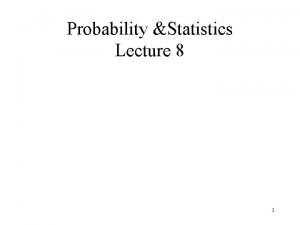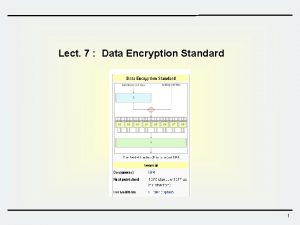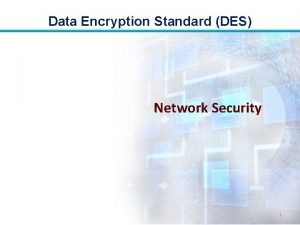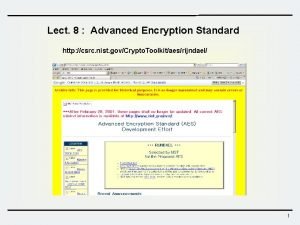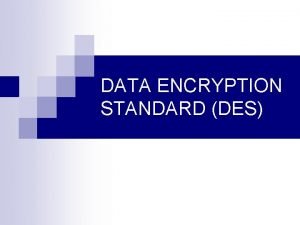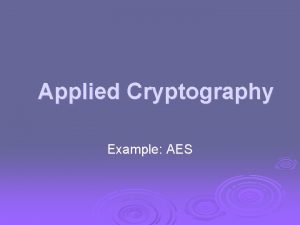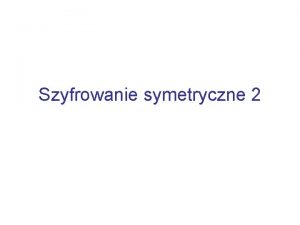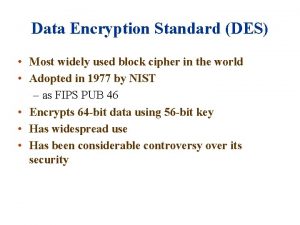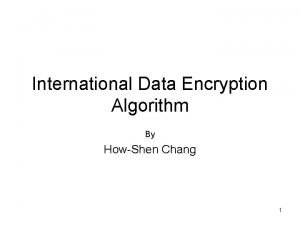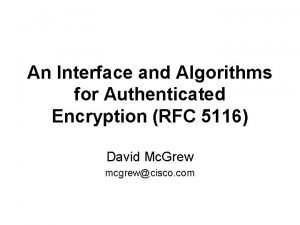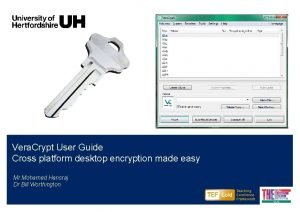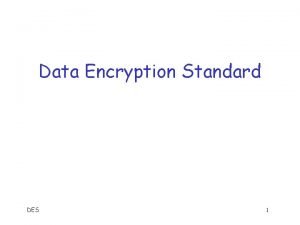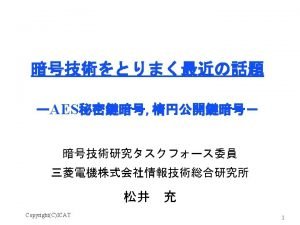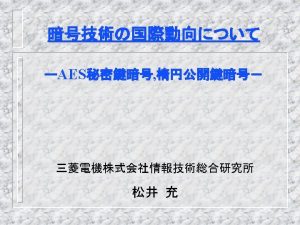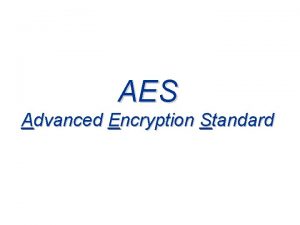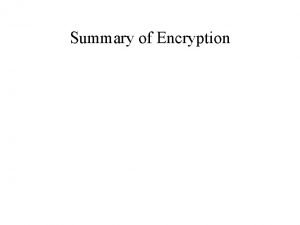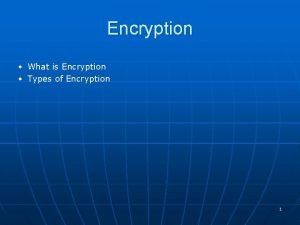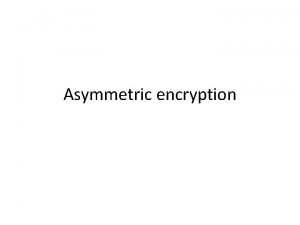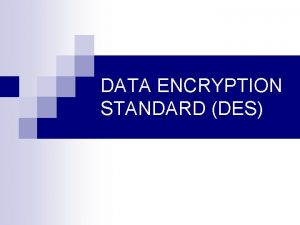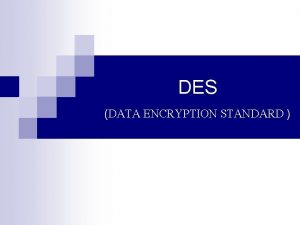Lect 7 Data Encryption Standard 1 Data Encryption

















- Slides: 17

Lect. 7 : Data Encryption Standard 1

Data Encryption Standard (DES) Ø DES - History ü 1976 – adopted as a federal standard ü 1977 – official publication as FIPS PUB 46 ü 1983, 1987, 1993 – recertified for another 5 years Ø Design Criteria of DES ü Provide a high level of security ü Completely specify and easy to understand ü Security must depend on hidden key, not algorithm ü Available to all users ü Adaptable for use in diverse applications ü Economically implementable in electronic device ü Able to be validated ü Exportable * Federal Information Processing Standards Plaintext block 64 bits DES Key 56 bits Ciphertext block 64 bits 2

DES Overview K P 64 PC-1 56 IP R 0(32) PC-2 L 0(32) Rot f 16 Round PC-2 R 16 L 16 FP 64 Round function Key Scheduling C 3

DES Overview Plaintext M(64) IP LE 0(32) RE 0(32) f LE 1(32) RE 1(32) f LE 2(32) K 1 K 2 RE 2(32) K 3 f LE 15(32) RE 15(32) f K 16 LE 16(32) RE 16(32) IP – 1 Ciphertext C(64) 4

Initial Permutation and Final Permutation IP – 1 (Final permutation) IP (Initial permutation) 58 50 42 34 26 18 10 2 40 8 48 16 56 24 64 32 60 52 44 36 28 20 12 4 39 7 47 15 55 23 63 31 62 54 46 38 30 22 14 6 38 6 46 14 54 22 62 30 64 56 48 40 32 24 16 8 37 5 45 13 53 21 61 29 57 49 41 33 25 17 9 1 36 4 44 12 52 20 60 28 59 51 43 35 27 19 11 3 35 3 43 11 51 19 59 27 61 53 45 37 29 21 13 5 34 2 42 10 50 18 58 26 63 55 47 39 31 23 15 7 33 1 41 9 49 17 57 25 cf. ) The 58 th bit of x is the first bit of IP(x) 5

Function f(ki, REi-1) REi-1(32 bits) E Expansion E 48 bits Ki (48 bits) S 1 S 2 S 3 S 4 S 5 P S 6 S 7 S 8 S-box Permutation P 32 bits 6

Expansion E and Permutation P Expansion E 32 1 2 3 4 5 16 7 20 21 4 5 6 7 8 9 29 12 28 17 8 9 10 11 12 13 1 15 23 26 12 13 14 15 16 17 5 18 31 10 16 17 18 19 20 21 2 8 24 14 20 21 22 23 24 25 32 27 3 9 24 25 26 27 28 29 19 13 30 6 28 29 30 31 32 1 22 11 4 25 cf. ) 32 -bits are expanded into 48 -bits. Some bits are selected more than once. 32 -bit permutation 7

S-box (substitution box) b 1 b 2 b 3 b 4 b 5 b 6 Look-up a value from the table using S 1 b 6 : row b 2 b 3 b 4 b 5 : column Sb 1 Sb 2 Sb 3 Sb 4 S 1 -box table b 1 b 6 : row 0 14 4 13 1 0 15 7 2 4 1 14 3 15 12 8 0 1 2 Sb 1 1 4 8 2 2 15 11 8 3 10 6 12 5 9 14 2 13 1 10 6 12 11 9 5 13 6 2 11 15 12 9 7 3 10 4 9 1 7 5 11 3 14 10 0 0 3 5 6 7 8 0 13 3 4 14 15 5 6 7 8 9 b 2 b 3 b 4 b 5 : column 10 11 12 13 8

DES S-Boxes S 3 -box 10 0 9 13 7 0 13 6 4 1 10 13 S 4 -box 14 9 9 0 6 3 3 4 8 15 6 9 15 5 6 10 3 0 8 7 1 13 12 7 11 4 2 8 5 14 12 11 15 1 11 1 2 12 5 10 14 7 4 15 14 3 11 5 2 12 7 13 14 3 0 6 9 10 1 13 8 11 5 6 15 0 3 4 10 6 9 0 12 11 7 13 15 0 6 10 1 13 8 9 2 7 1 4 8 5 11 12 4 15 2 12 1 10 14 9 3 14 5 2 8 4 5 11 12 7 2 14 9

DES S-boxes Ø 8 S-boxes (6 4 bits) Øsome known design criteria ünot linear üAny one bit of the inputs changes at least two output bits üS(x) and S(x 001100) differs at least 2 bits üS(x) S(x 11 ef 00) for any ef üResistance against DC etc. üThe actual design principles have never been revealed (US classified information) HW : For the S 4 -box, check whether the following property holds üS 4 (x) and S 4 (x 001100) differs at least 2 bits 10

Key Scheduling Key (64) PC 1 C 0(28) D 0(28) LS 1 C 1(28) D 1(28) LS 2 C 2(28) D 2(28) LS 16 C 16(28) D 16(28) PC 2 K 1 PC 2 K 2 PC 2 K 16 11

PC 1 57 1 10 19 63 7 14 21 49 58 2 11 55 62 6 13 41 50 59 3 47 54 61 5 33 42 51 60 39 46 53 28 25 34 43 52 31 38 45 20 17 26 35 44 23 30 37 12 9 18 27 36 15 22 29 4 64 bit -> 56 bit (Actual key size of DES is 56 -bit) cf. ) Do not use the parity check bits preventing from input error. 8 16 24 32 40 48 56 64 was not selected. 12

PC 2 14 3 23 16 41 30 44 46 17 28 19 7 52 40 49 42 11 15 12 27 31 51 39 50 24 6 4 20 37 45 56 36 1 21 26 13 47 33 34 29 5 10 8 2 55 48 53 32 56 bit -> 48 bit Note that 9, 18, 22, 25, 38, 43 and 54 th positions was not selected. 13

Left Shift LSs Iteration LS 1 LS 2 LS 3 LS 4 LS 5 LS 6 LS 7 LS 8 Shift 1 1 2 2 2 Iteration LS 9 LS 10 LS 11 LS 12 LS 13 LS 14 LS 15 LS 16 Shift 1 2 2 2 1 14

Breaking DES(1/2) Ø DES - Controversies ü Unknown design criteria ü Slow in software ü Too short key size – 56 bits Ø DES Crack Machine ü Can test over 90 billion keys per second ü EFF's "Deep Crack" and the Distributed. Net computers were testing 245 billion keys per second ü On Jan. 19, 1999, RSA DES-III Challenge was deciphered after searching 22 h. and 15 m. Identifier: DES-Challenge-III http: //www. rsa. com/rsalabs/node. asp? id=2108 Cipher: DES Start: January 18, 1999 9: 00 AM PST Prize: $10, 000 IV: da 4 b be f 1 6 b 6 e 98 3 d Plaintext: See you in Rome (second AES Conference, March 22 -23, 1999) 15

Breaking DES(2/2) 250, 000$@1998 10, 000$@2008

Double DES & Triple DES v How to strengthen existing DES implementations ? v Double DES Ø Essentially no security increase: EK 1(P) = X = DK 2(C) Meet-in-the-middle attack ! K 2 K 1 E P X K 1 K 2 E C X D C D P v Triple DES Ø Three-key or Two-key 3 DES: K 1 = K 3 P E A D B E C C D K 1 K 2 K 3 K 2 K 1 B E A D P 17
 Var lect
Var lect Block ciphers and the data encryption standard
Block ciphers and the data encryption standard Data encryption standard exercice corrigé
Data encryption standard exercice corrigé Data encryption standard
Data encryption standard Des in information security
Des in information security Nist data encryption standard
Nist data encryption standard Data encryption standard history
Data encryption standard history Homomorphic encryption standard
Homomorphic encryption standard Advanced encryption standard example
Advanced encryption standard example Algorytm aes
Algorytm aes The most widely used encryption standard is
The most widely used encryption standard is International data encryption algorithm
International data encryption algorithm Authenticated encryption with associated data (aead)
Authenticated encryption with associated data (aead) Estimated standard error of mean
Estimated standard error of mean Difference between standard language and home language
Difference between standard language and home language Disadvantages of standard costing system
Disadvantages of standard costing system Mbk berkefungsian sederhana
Mbk berkefungsian sederhana Vera krypt
Vera krypt
